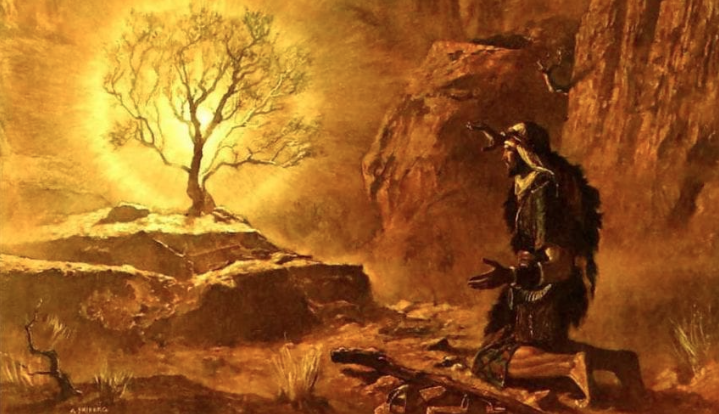
What if Jesus Christ, the Catholic Church, and the Sacraments were all encoded within the Exodus?
My newly published book, Burning Bush, Burning Hearts: Exodus as Paradigm of the Gospel, examines this very question. The book offers in-depth commentary on the underlying symbolism hidden within the story of Exodus that points directly to the Catholic faith.
Much has been written on the many scriptural prophecies in the Old Testament concerning the coming of the Messiah. These are well-known. However, much less attention has been given to the prophetic symbolism embedded in the Old Testament that points to the coming of Christ in unspoken signs and symbols. My book focuses specifically on these unspoken prophecies—the divinely inspired symbols embedded with people, places, things, and miraculous occurrences. These unspoken prophecies are the typologies hidden within Exodus.
The whole story of the Exodus is a foreshadowing of the coming of Christ. It is interwoven with signs and symbols for the New Covenant. The Apostles and the early Church Fathers refer to this symbology in the Old Testament as “types” and “figures.” This typology is most pronounced in Exodus. The typologies in Exodus are so central that they reveal quite explicitly, through symbology, the coming of the Messiah and his sacrificial mission. If Genesis 3:15 is the protoevangelium, then, Exodus is the full-fledged Old Testament Gospel. The Exodus predicts the Gospel so strikingly that it could very aptly be called “The New Exodus” or “The Second Exodus.”
The signs and symbols of Exodus offer a preview of the coming Redemption. The Exodus was the preview of the Incarnation. The types of the Old Testament gave way to the reality of Christ, the Church, and the Sacraments. These types can be seen in the main characters of Exodus, in Moses, and Aaron, and Joshua. They can be seen in the main events of Exodus: the Passover lamb, the crossing of the Red Sea, the theophany on Mount Sinai. The types can be seen in the miraculous objects too: the manna from Heaven, the water from the rock, the column of cloud and the pillar of fire, the bronze serpent on the pole, the Tabernacle. The typologies can be seen as well in the individual sacrifices, such as the daily whole burnt offering, the Yahweh and Azazel goats, and the red heifer. They can be seen in the appointed times of the Jewish feasts as well. All was type and symbol. The Exodus is filled to the brim with typological prophecies of Christ.
The truth is these typologies are found throughout the Bible and the writings of the early Church Fathers. St. John the Baptist knew these typologies well, as he exclaims in the presence of Jesus: “Behold, the Lamb of God, who takes away the sin of the world!” (John 1:29) St. Paul, and the rest of the Apostles, knew these typologies as well too, as he states matter-of-factly: “These are only a shadow of what is to come; but the substance belongs to Christ” (Col. 2:17). In his letter to the Corinthians, St. Paul goes into this in more detail:
“I want you to know, brethren, that our fathers were all under the cloud, and all passed through the sea, and all were baptized into Moses in the cloud and in the sea, and all ate the same supernatural food and all drank the same supernatural drink. For they drank from the supernatural Rock which followed them, and the Rock was Christ.” (1 Cor. 10:1-4)
He is proclaiming the typologies of Exodus as revealed in the person of Jesus Christ and the Sacraments. The Israelites passed through the Red Sea guided by the column of cloud and the pillar of fire. As the Fathers explain, the Red Sea is a type of a baptismal font. The Israelites go down into the waters of Baptism in crossing the sea and reemerge from the other side. The Holy Spirit as the cloud and the fire blesses the waters of the Sea. Pharaoh and the Egyptian soldiers are a type for sin. As they chase the Israelites through the Sea, the waters fall back down upon them, drowning and wiping them away. The water of Baptism similarly wipes away Original Sin and all of our sins, just as the Egyptians are washed away from the Israelites. Similar expositions can be made of the manna from Heaven and the water from the rock to the Eucharist and the Holy Spirit.
My book attempts to plumb the depths of these many varied instances in Exodus and their foreshadowing of the reality to come. Christ is the new Moses and the new Joshua leading us in this new Exodus. The Israelites were freed from slavery and oppression under Pharaoh. The Cross of Christ similarly frees us from the slavery of sin and death. Jesus is the fulfillment of Moses as a type of redeemer of his people. Just as Moses is the redeemer of his people the Israelites, so too, is Christ is the true Redeemer of all people through the Church. Moses is the singular person who offers atonement for the Israelites as the forerunner to Christ, who is the one Mediator between God and humanity.
The typologies of Exodus point towards Christ’s First Coming in his Incarnation. They point also towards the seven Sacraments of the Catholic Church. Finally, the typologies of Exodus point towards Christ’s Second Coming and the end of the world. My book tries to offer insights into each of these occurrences through the symbols found in Exodus. The typologies of Exodus are our blueprint and roadmap. They reveal to us how we are to live our lives, in our own Exodus, in the desert wilderness of this world, in order that we may enter into the Promised Land of Heaven.
